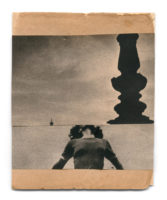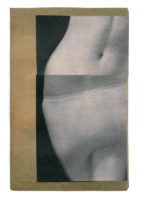I’m not sure most photographers are aware of what’s going on in the world of collage. Much like photography itself, collage is easy to do and almost impossibly hard to do well. When it’s done well, it easily competes with other forms of art in terms of expressiveness and sheer beauty. Given most collage relies on photography, there are many lessons to be learned for photographers. The photographer’s task is to look, to find and then preserve the moment that is worthwhile being treated that way. Collage artists operate in very similar ways, the only difference being that their source material is different (and even that difference is now becoming ever more irrelevant, given contemporary photographic practice involves looking at archives).
Katrien de Blauwer‘s work has been on my radar for a while. Her work evokes that of John Stezaker, but there are very different sensibilities being explored. As much as I enjoy Stezaker’s work, it often comes across as being just a tad too clever, too cerebral. I never had this problem with De Blauwer’s collages. Given my ongoing interest in and fascination with her work, I thought it would be nice to have a little conversation about it all.
Jörg Colberg: Can you talk a little bit about your background?
Katrien de Blauwer: I have been making collages for as long as I can remember. At 18 I rolled into fashion school for a couple of years, and the funny thing is I only got up to making mood books that consisted of little fragments of magazines. All my effort went into them.
I’m a sensitive person and emotions are my main motivation. I try to express that through my works. They’re all translations of themes that keep me busy and bubble out of me. That’s why certain elements reappear and why my work often is a variation on a range of themes. Because of that it also has grown a certain maturity after all these years. If you do something for a long time, you’re always getting better in it. It’s like learning a language. Recently I saw a documentary about Michelangelo Antonioni in which he said: “If one asks me a question, I answer by making a movie”. There’s a lot in it, I think. He used his films as his language, and I use my collages.



JC: Given you use collages as a language, if you had to tell people about what your collages would speak of what would you say?
KdB: My collages speak about myself, about what’s keeping me busy. They’re my stories, how I deal with the past. My grip on reality, my ritual and routine.
A few weeks ago somebody was at my home to look at my work, when she suddenly said “you look like your work”. That was a very nice observation and compliment.
JC: This site focuses mostly on photography itself, so can you talk a little bit of what you actually do and how you do it? Where do you find your source materials? And, especially, how do you go about making your pieces? Do you have an archive of material, sorted in some way?
KdB: I would like to describe myself as a “photographer without a camera”. I’m re-reading and re-using photographs. The framing is not taking place in the lens, but in the eye. My works calls to mind the technique of photomontage or film editing. They’re stills but nevertheless preserve a filmic vibration.
I use a very spontaneous way of working. First I roughly cut out a selection of images and backgrounds, then I start creating in what is usually a few hours session. I always try to work out of my unconscious. By this way of working I come to unexpected results. Sometimes someone points out something I had overlooked at first: a line that fits perfectly, a figure that is connected in two images or an unusual association.
Yes, I have a huge (unsorted) ever growing archive. It’s a treat to find some rare unknown magazine. If I travel abroad, it’s always with the idea of finding new material.
JC: What is your relationship to the source materials? When you look through magazines, say, how do you approach the photographs? Do you look for specific details, or do you find them?
A: I go through magazines rather fast. I know immediately if there’s a part of an image I can use. I developed some kind of sensitivity for this. There are of course some images (or parts) that always draw my attention, some details that reappear often, but that’s what makes it interesting for me. These pieces act like a mirror, they’re telling me something about myself. There’s a strong therapeutical value in all these pieces. I need to make them. It’s like breathing.
Some time ago somebody was looking through my work and suddenly noticed: “There’s almost never a man in your works”. He was right, I never noticed it. But outside from the “Rendez-vous” series where there’s always a man and a woman, I can count the collages with a man on one hand.
JC: So what are you going to do about it, work more consciously on adding men, or simply exploring what this all means? The photographer’s job usually never ends with taking pictures: there is the process of editing, of engaging with and learning from the work afterwards. How does this work for you? Do you look at your work once it’s done, to find out what it tells you? Or if it’s done it’s done?
KdB: No, I’m not going to add men, the fact that there are no men in my work has a reason of which I became fully aware after the remark.
Making collages is re-using existing material so the process of editing starts before the actual process of creating.
After the work’s done, I display all the new pieces on a table, and then I start to see different moods, techniques and pieces that jump out. Afterwards I categorize the works, mostly by theme, but also by the feeling I have for a work. Really strong pieces are usually kept apart and displayed in my work space.
I re-look at my work afterwards. When we where working on the book for example, we had to go through all the archive and make a selection, which was very interesting, because I started to look at older works in a new context.



JC: I’m curious, what is it that collage (or maybe one should really call it montage) do that photography itself cannot do? Where do they overlap, and what are their differences?
KdB: Difficult to say, there are of course different forms of photography and also different forms of collage. My collages are more direct, maybe you can compare them to classic black-and-white snapshots, but without a camera involved, no technical issues. The cut is the click. Making collages is a post-photographic process, giving new meaning and live to what is residual, saving images from destruction and including them in a new narration.
My work is very intimate, it comes from my inner world and asks questions about my personal life, body, sexuality… But at the same time it’s also very anonymous by using images from magazines. I almost act as a neutral person between my story and somebody else’s. I did not make all these images, but I’m giving them a new meaning. I take stories from others in my personal world and by cutting away faces my personal story becomes everybody’s story and universal.
JC: Photographers often (usually?) start out with quite specific ideas (maybe in the form of projects) from which work then evolves. Is that how you work? Or do you approach your work in a different way, and if yes, how?
KdB: I have quite a fixed (almost) daily working scheme, and I’m also very productive. I try to work very spontaneously, without really a plan in mind. Sometimes my work evolves in a certain direction. Now for example I’m working on the “Single cuts” series, where one photograph is cut, divided and recomposed again to form a new, double image. I discovered this technique some time ago, and I’m experimenting a lot with it now, pushing it to the limits until something different comes out.
Lately, my work is moving more towards a void and emptiness, almost abstraction, while only one year ago I worked on the “Rendez-vous” and “Féminin” series. I think there’s always a slow evolution in my work.
